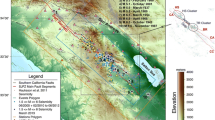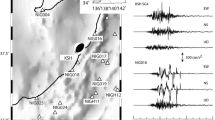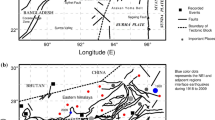Abstract
We assess the significance of rupture-plane uncertainty in the estimated ground-motion intensity measures (IMs) by using the centroid moment-tensor and fault-plane solutions as well as the ground-motion recordings of the 30 October 2020 Samos Earthquake. We sampled ground-motion fields using stochastically generated rupture planes by considering the uncertainties imposed from alternative fault-plane solutions to reach our objective. Our observations indicate that the compromise between rupture-plane uncertainty and variability in the predicted ground-motion IMs depends on the modeling complexity of the ground-motion predictive model (GMPM). It also depends on the spatial location of the site relative to the ruptured fault. This conclusive remark is important for modelers who perform regional or site-specific seismic hazard and risk analyses. The presented case studies are also useful for GMPM developers because the ground-motion models contain predictor parameters, the most ubiquitous one is source-to-site distance, that are affected from rupture-plane geometry. Depending on the level of model complexity, the number of predictor parameters affected from rupture-plane geometry can increase and therefore the estimated ground-motion IMs can become more prone to rupture-plane uncertainty. Confined to our case-specific observations, we intend to make some suggestions to hazard, risk, and GMPM modelers for the consideration of rupture-plane uncertainty at the end of the paper.










Similar content being viewed by others
Data availability
Strong-motion data, as well as seismological information provided by the seismic networks, are cited in the paper.
Code availability
In-house custom codes written in Matlab are used in the paper. All affiliated universities provide academic Matlab licenses.
Notes
https://www.emsc-csem.org/Earthquake/tensors.php?view=4—last accessed on 24/11/2020.
https://earthquake.usgs.gov/earthquakes/eventpage/us7000c7y0/finite-fault—last accessed on 24/11/2020.
References
Akkar S, Cheng Y (2016) Application of a Monte-Carlo simulation approach for the probabilistic assessment of seismic hazard for geographically distributed portfolio. Earthquake Eng Struct Dyn 45:525–541
Akkar S, Sandikkaya MA, Bommer JJ (2014a) Empirical ground-motion models for point- and extended-source crustal earthquake scenarios in Europe and the Middle East. Bull Earthq Eng 12(1):311–339
Akkar S, Sandıkkaya MA, Şenyurt M, Sisi Azari A, Ay BÖ, Traversa P, Douglas J, Cotton F, Luzi L, Hernandez B, Godey S (2014b) Reference database for seismic ground-motion in Europe (RESORCE). Bull Earthq Eng 12(1):359–387
Altunel E, Pinar A (2020) Kusadasi Gulf earthquake in the frame of active faults of Western Turkey”. Turkish J Earth Sci. https://doi.org/10.3906/yer-2011-6
Ancheta TD, Darragh RB, Stewart JP, Seyhan E, Silva WJ, Chiou BSJ, Wooddell KE, Graves RW, Kottke AR, Boore DM, Kishida T and Donahue JL (2013). “PEER NGA-West2 Database,” Report No. PEER 2013/03, Pacific Earthquake Research Center, University of California at Berkeley.
Atkinson G, Silva W (2000) Stochastic modeling of California ground motions. Bull Seismol Soc Am 90:255–274
Beresnev IA (2003) Uncertainties in finite-fault slip inversions: to what extent to believe? (a critical review). Bull Seismol Soc Am 93(6):2445–2458
Bommer JJ, Akkar S (2010) Consistent source-to-site distance metrics in ground-motion prediction equations and seismic source models for PSHA. Earthq Spectra 28(1):1–15
Boore DM (2010) Orientation-independent, non geometric-mean measures of seismic intensity from two horizontal components of motion. Bull Seismol Soc Am 100:1830–1835
Boore DM, Sisi Azari A, Akkar S (2012) Using pad-stripped acausally filtered strong-motion data. Bull Seismol Soc Am 102:751–760
Boore DM, Stewart JP, Seyhan E, Atkinson G (2014) NGA-West 2 equations for predicting PGA, PGV, and 5%-damped PSA for shallow crustal earthquakes. Earthq Spectra 30(3):1057–1085
Chen Q, Seifried A, Andrade JE, Baker JW (2012) Characterization of random fields and their impact on the mechanics of geosystems at multiple scales. Int J Numer Anal Meth Geomech 36(2):140–165
Chiou BS-J and Youngs RL (2008). “NGA Model for Average Horizontal Component of Peak Ground Motion and Response Spectra,” Report No. PEER 2008/09, Pacific Earthquake Research Center, University of California at Berkeley.
Chiou BS-J, Youngs R (2014) Update of the Chiou and Youngs NGA model for the average horizontal component of peak ground motion and response spectra. Earthq Spectra 30(3):1117–1153
Dawood HM, Rodriguez-Marek A, Bayless J, Goulet C, Thompson E (2016) A Flatfile for the KiK-net database processed using an automated protocol. Earthq Spectra 32:1281–1302
Douglas J, Boore DM (2011) High-frequency filtering of strong-motion records. Bull Earthq Eng 9:395–409
Ganas A, Elias P, Briole P, Tsironi V, Valkaniotis S, Escartin J, Karasante I, Efstathiou E (2020) Fault responsible for Samos earthquake identified, Temblor. https://doi.org/10.32858/temblor.134. https://temblor.net/earthquake-insights/fault-responsible-for-samos-earthquake-identified-12040. Accessed 10 April 2020
Goda K, Hong HP (2008) Spatial correlation of peak ground motions and response spectra. Bull Seismol Soc Am 98(1):354–365
Hanks TC, Kanamori H (1979) A moment magnitude scale. JGR Solid Earth 84(B5):2348–2350
Ji C, Wald DJ, Helmberger DV (2002) Source description of the 1999 Hector Mine, California, Earthquake, Part I: Wavelet domain inversion theory and resolution analysis. Bull Seismol Soc Am 92(4):1192–1207
Kaklamanos J, Baise LG, Boore DM (2011) Estimating unknown input parameters when implementing the NGA ground-motion prediction equations in engineering practice. Earthq Spectra 27:1219–1235
Kale O, Akkar S, Ansari A, Hamzehloo H (2015) A ground-motion predictive model for Iran and Turkey for horizontal PGA, PGV, and 5% damped response spectrum: investigation of possible regional effects. Bull Seismol Soc Am 105(2A):963–980
Kawamoto S, Ohta Y, Hiyama Y, Todoriki M, Nishimura T, Furuya T, Sato Y, Yahagi T, Miyagawa K (2017) REGARD: A new GNSS-based real-time finite fault modeling system for GEONET. J Geophys Res Solid Earth 122:1324–1349
Leonard M (2010) Earthquake fault scaling: Self-consistent relating of rupture length, width, average displacement and moment release. Bull Seismol Soc Am 100(5A):1971–1988
Mai PM, Spudich P, Boatwright J (2005) Hypocenter locations in finite-source rupture models. Bull Seismol Soc Am 95(3):965–980
Wills CJ, Silva W (1998) Shear-wave velocity characteristics of geologic units in California. Earthq Spectra 14(3):533–556
Acknowledgements
The authors are thankful to Dr. Ganas (National Observatory of Athens) for providing the preliminary version of the fault-plane solution published in Ganas et al. (2020). The authors also thank to Professors Arda Ozacar (Middle East Technical University), Ali Pinar (Bogazici University) and Erhan Altunel (Osmangazi University) for their valuable insights about the Samos earthquake, regional tectonics and our rupture scenarios. We also thank two anonymous reviewers for their constructive comments that helped us going over many details in the original submission.
Funding
This research is not supported by a private or state entity.
Author information
Authors and Affiliations
Contributions
All authors contributed to the study's conception and design. Material preparation, data collection and analysis were performed by Sinan Akkar, Özkan Kale, N. Merve Çağlar, Ufuk Yazgan and Mustafa Abdullah Sandıkkaya. The manuscript was written by Sinan Akkar and all authors commented on previous versions of the manuscript. All authors read and approved the final manuscript.
Corresponding author
Ethics declarations
Conflict of interest
The author declared that there is no conflict of interest.
Additional information
Publisher's Note
Springer Nature remains neutral with regard to jurisdictional claims in published maps and institutional affiliations.
Rights and permissions
About this article
Cite this article
Akkar, S., Çağlar, N.M., Kale, Ö. et al. Impact of rupture-plane uncertainty on earthquake hazard: observations from the 30 october 2020 Samos earthquake. Bull Earthquake Eng 19, 2739–2761 (2021). https://doi.org/10.1007/s10518-021-01099-9
Received:
Accepted:
Published:
Issue Date:
DOI: https://doi.org/10.1007/s10518-021-01099-9




